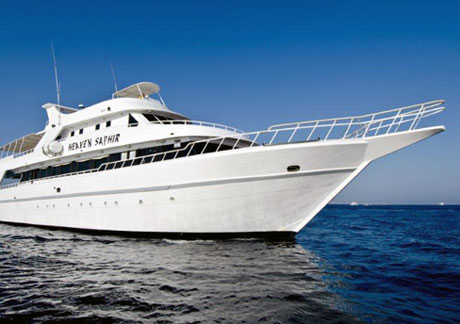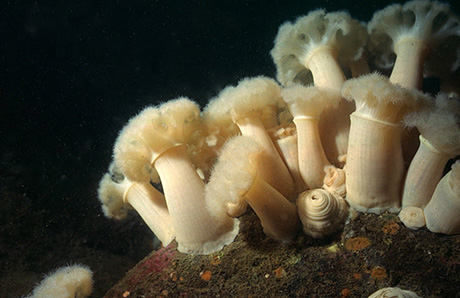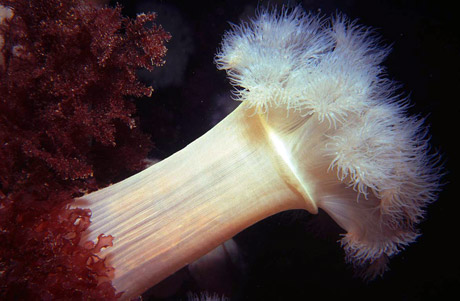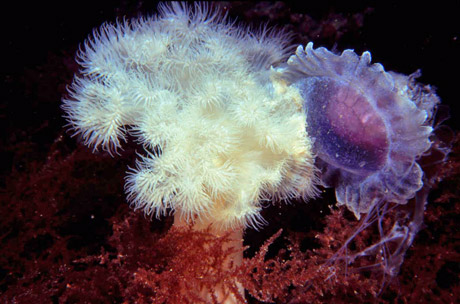Welcome to the 215th issue SCUBA News. I hope you find it useful. Any questions or comments email news@scubatravel.co.uk.
You can download a pdf version of SCUBA News here.
Liveaboard Deals
Save 40% on St Johns liveaboard in the Red Sea
Dive Egypt's most southerly spots

For beautiful deep walls and oceanic white tip sharks.
Learn More…
Letters
I wonder if anyone else feels this way about dive travel. How many have booked dive travel through a shop? You are basically paying for the dive shop person to go on a trip and take their pics . I do not see any added value they offer. Would love to hear others views.
Sean S, via Twitter
https://twitter.com/scubaseansa/status/985890309170126849
Attack of the killer clones: Plumose anemones strike their neighbours
You often see small forests of Plumose anemones when diving in temperate waters. The is due to their ability to clone themselves.

Genetically different patches of clones are often separated by narrow paths free of anemones. Along the edges of these corridors, the anemones often possess two types of tentacle. One type for catching food and one much smaller type which can expand tremendously. They use these expanding tentacles to reach over and attack non-identical anemones across the border. The tip of the tentacle doesn't hurt anemones the same as itself, it only discharges its stinging nematocysts upon contact with a genetically different individual. After stinging the tentacle breaks, leaving about 1 cm of the tip attached to the victim. The tissue around the sting dies as, occasionally, does the victim.

Plumose anemones comprise a tall, smooth column topped with a crown of feathery tentacles. When they contact they look like swirly blobs.
Individuals are usually white or orange, although they are sometimes dark green, grey or brown in colour. They grow up to 30 cm tall and 15 cm across at the base. They like areas with currents so tend to live on prominent pieces of wrecks or on rocky pinnacles - in other words, in good diving areas

With fine, delicate tentacles they are unsuited to capturing large animals like fish. Instead they specialise in smaller prey such as small planktonic crustaceans. The anemone's columnar body is narrower just below the tentacles. A current will bend the stalk at this point and expose the tentacles broadside to the flow in the best position for feeding on suspended matter.

The Plumose anemone occurs from the Bay of Biscay (North of Spain) to Scandinavia in the northeast Atlantic, and on the west and east coasts of North America. It is unknown from the western basin of the Mediterranean but has been seen in the Adriatic, where it is believed to have been introduced. It has also been seen in Table Bay Harbour in South Africa where it was probably introduced from Europe.

Plumose anemone with jellyfish
The common name comes from pluma - feather. The Latin name, which it was given by Linnaeus, is Metridium senile which means Fruitful old - probably a reference to its cloning ability. There is some confusion as to whether this has been replaced by the name M. dianthus, but M. senile is still the accepted name according to ITIS - the Integrated Taxonomic Information System. M dianthus is listed as a different species but with "data quality indicators unverified".
Animalia (Kingdom) > Cnidaria (Phylum) > Anthozoa (Class) > Hexacorallia (Subclass) > Actiniaria (Order) > Enthemonae (Suborder) > Metridioidea (Superfamily) > Metridiidae (Family) > Metridium (Genus) > Metridium senile (Species)
Photos copyright Tim Nicholson, taken off the Isle of Man
Read the full story here. Previous creatures of the month are in our Marine Life section.
Our round up of the best underwater news stories of the past month. For breaking news see our Twitter page or RSS feed
SCUBA News is licensed under a Creative Commons Attribution 4.0 Unported License. This means we are happy for you to reuse our material for both commercial and non-commercial use as long as you: credit the name of the author, link back to the SCUBA Travel website and say if you have made any changes. Some of the photos though, might be copyright the photographer. If in doubt please get in touch.
Photo credits: Tim Nicholson, Jill Studholme
Previous editions of SCUBA News are archived at http://www.scubatravel.co.uk/news.html
SUBSCRIBING AND UNSUBSCRIBING
Visit Unsubscribe and add or remove your e-mail address. To change whether your receive the newsletter in text or HTML (with pictures) format visit this link
ADVERTISING
Should you wish to advertise in SCUBA News, please see the special offers at
http://www.scubatravel.co.uk/newsad.html
Other advertising opportunities are at
http://www.scubatravel.co.uk/advertising.html
CONTACTING THE EDITOR
Please send your letters or press releases to:
Jill Studholme
SCUBA News
The Cliff
Upper Mayfield
DE6 2HR
UK
news@scubatravel.co.uk
PUBLISHER
SCUBA Travel Ltd, 5 Loxford Court, Hulme, Manchester, M15 6AF, UK
No comments:
Post a Comment